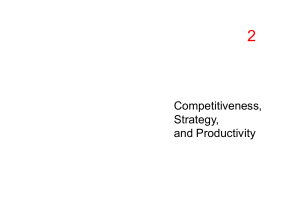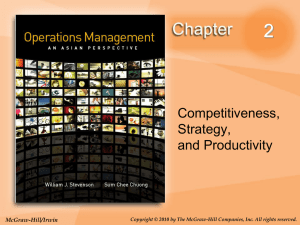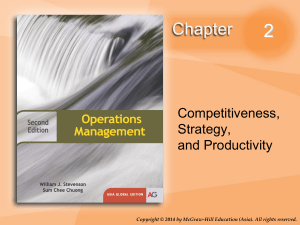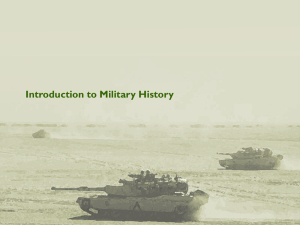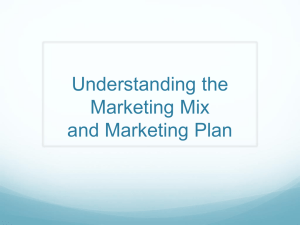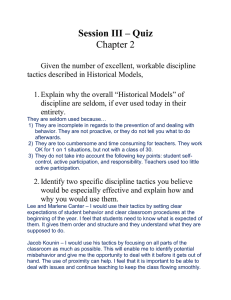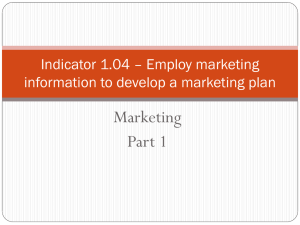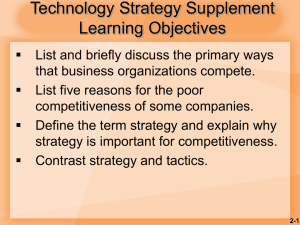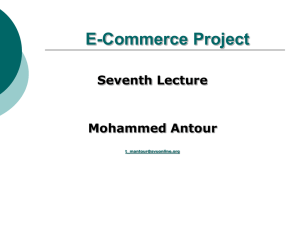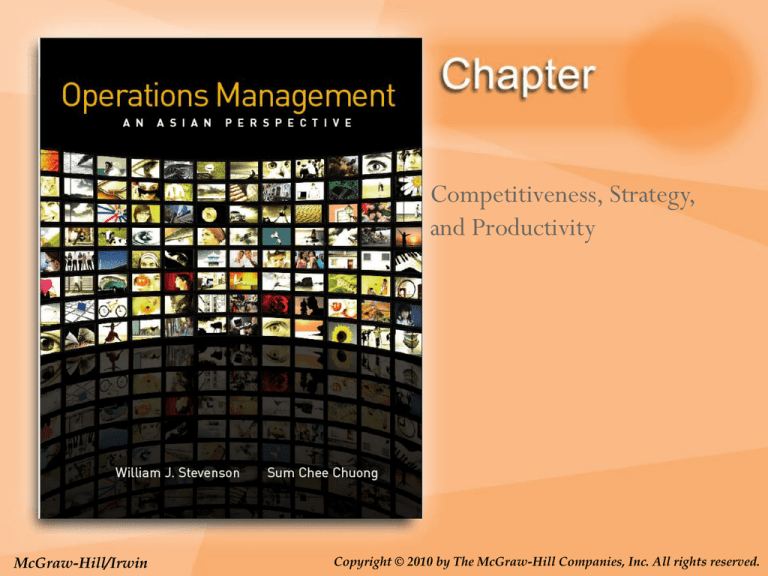
2
McGraw-Hill/Irwin
Competitiveness, Strategy,
and Productivity
Copyright © 2010 by The McGraw-Hill Companies, Inc. All rights reserved.
Competitiveness:
How effectively an organization meets the
wants and needs of customers relative to
others that offer similar goods or services
2-2
Businesses Compete Using Marketing
Identifying consumer wants and needs
Pricing
Advertising and promotion
2-3
Businesses Compete Using Operations
Product and service design
Cost
Location
Quality
Quick response
Flexibility
Inventory management
Supply chain management
Service and service quality
Managers and workers
2-4
Why Some Organizations Fail
Too much emphasis on short-term
financial performance
Failing to take advantage of
strengths and opportunities
Neglecting operations strategy
Failing to recognize competitive
threats
2-5
Why Some Organizations Fail
Too much emphasis in product and
service design and not enough on
improvement
Neglecting investments in capital and
human resources
Failing to establish good internal
communications
Failing to consider customer wants and
needs
2-6
Mission/Strategy/Tactics
Mission
2-7
Strategy
Tactics
Strategy
Mission
Explains
the existence for an organization
Mission Statement
States
the purpose of an organization
Goals
Provide
detail and scope of mission
Strategies
Plans
for achieving organizational goals
Tactics
The
methods and actions taken to accomplish
strategies
2-8
Mission
Mission
The reason for an organization’s existence
Mission statement
States the purpose of the organization
The mission statement should answer the question of
“What business are we in?”
Mission Statement
McDonald's brand mission is to "be our customers' favorite place
and way to eat." Our worldwide operations have been aligned
around a global strategy called the Plan to Win centering on the
five basics of an exceptional customer experience -- People,
Products, Place, Price and Promotion. We are committed to
improving our operations and enhancing our customers'
experience.
http://www.mcdonalds.com/corp/about/mcd_faq/student_research.html
JOHNSON & JOHNSON PACIFIC CONSUMER SERVICE CENTRE
We will delight our consumers, treating each person who contacts us as if
they are our only consumer, providing them with a response which is
evidence of our interest and that leaves them with the clear understanding
that they are important to us.
UNIVERSITY OF MALAYA
Mission To advance knowledge and learning through quality research and
education for the nation and for humanity.
Goals
The mission statement serves as the basis for
organizational goals
Goals
Provide detail and the scope of the mission
Goals can be viewed as organizational destinations
Goals serve as the basis for organizational strategies
Strategies
Strategy
A plan for achieving organizational goals
Serves as a roadmap for reaching the
organizational destinations
Organizations have
Organizational strategies
Overall strategies that relate to the entire
organization
Support the achievement of organizational goals
and mission
Functional level strategies
Strategies that relate to each of the functional
areas and that support achievement of the
organizational strategy
Tactics and Operations
Tactics
The methods and actions taken to
accomplish strategies
The “how to” part of the process
Provide guidance and directions for carrying
out actual operations
Operations
The actual “doing” part of the process
Planning and Decision Making
Figure 2.1
Mission
Organizational
Goals
Organizational Strategies
Functional Goals
Finance
Strategies
Tactics
2-14
Operating
Procedures
Marketing
Strategies
Tactics
Operating
Procedures
Operations
Strategies
Tactics
Operating
Procedures
Strategy Example
Example 1
Jun Hee is a high school student. She
would like to have a career in business,
have a good job, and earn enough income
to live comfortably
Mission:
Goal:
Strategy:
Tactics:
Operations:
2-15
Live a good life
Successful career, good income
Obtain a college education
Select a college and a major
Register, buy books, take
courses, study
Strategy and Tactics
Distinctive Competencies
The special attributes or abilities that give an
organization a competitive edge.
Strategy Factors
Price
Quality
Time
Flexibility
Service
Location
2-16
Examples of Operations Strategies
Table 2.2
2-17
Price
Low Cost
National first-class postage,
Carrefour, Jetstar
Quality
High-performance design Sony TV, Lexus, Disneyland
and/or high quality
Consistent quality
Time
Rapid delivery
On-time delivery
Coca-Cola, PepsiCo, Kodak,
McDonald’s restaurants, UPS
Pizza Hut, FedEx
Flexibility
Variety
Volume
Burger King
McDonald’s
Service
Superior customer
service
Disneyland, HewlettPackard, IBM
Location
Convenience
Supermarkets, dry cleaners
Global Strategy
Strategic decisions must be made with respect to
globalization
What works in one country may not work in
another
Strategies must be changed to account for these
differences
Other issues
2-18
Political, social, cultural, and economic differences
Strategy Formulation
Distinctive competencies
Environmental scanning
SWOT
Order qualifiers
Order winners
2-19
Strategy Formulation
Order qualifiers
Characteristics that customers perceive as minimum
standards of acceptability to be considered as a
potential purchase
Order winners
Characteristics of an organization’s goods or
services that cause it to be perceived as better than
the competition
Characteristics such as price, delivery reliability,
delivery speed and quality can be order qualifiers or
order winners.
2-20
Internal Factors & External Factors
Key External Factors
Key Internal Factors
Economic conditions
Human Resources
Political conditions
Facilities and
Legal environment
Technology
Competition
Markets
equipment
Financial resources
Customers
Products and services
Technology
Suppliers
Operations Strategy
Operations strategy: The approach consistent
with organization strategy, that is used to guide
the operations function.
2-22
Strategic OM Decisions
Table 2.4
Decision Area
Affects
Product and service design
Costs, quality liability and environmental
Capacity
Cost structure, flexibility
Process selection and layout
Costs, flexibility, skill level, capacity
Work design
Quality of work life, employee safety, productivity
Location
Costs, visibility
Quality
Ability to meet or exceed customer expectations
Inventory
Costs, shortages
Maintenance
Costs, equipment reliability, productivity
Scheduling
Flexibility, efficiency
Supply chains
Costs, quality, agility, shortages, vendor relations
Projects
Costs, new products, services, or operating systems
2-23
Quality and Time Strategies
Quality-based strategies
Focuses on maintaining or
improving the quality of an
organization’s products or
services
Quality at the source
Time-based strategies
Focuses on reduction of time
needed to accomplish tasks
2-24
Time-Based Strategies
JAN
FEB
MAR
APR
MAY
JUN
Planning
Designing
Processing
Changeover
Delivery
2-25
On time!
Productivity
Productivity
A measure of the effective use of resources,
usually expressed as the ratio of output to
input
Productivity ratios are used for
Planning workforce requirements
Scheduling equipment
Financial analysis
2-26
Productivity
Partial measures
output/(single
input)
Multi-factor measures
output/(multiple inputs)
Total measure
output/(total inputs)
Output
Productivity =
Input
2-27
Productivity Growth
Productivity Growth =
Current Period Productivity – Previous Period Productivity
Previous Period Productivity
2-28
Measures of Productivity
Table 2.5
Partial
measures
Multifactor
measures
Total
measure
2-29
Output
Labor
Output
Output
Machine Capital
Output
Labor + Machine
Output
Energy
Output
Labor + Capital + Energy
Goods or Services Produced
All inputs used to produce them
Examples of Partial Productivity Measures
Table 2.6
2-30
Labor
Productivity
Units of output per labor hour
Units of output per shift
Value-added per labor hour
Machine
Productivity
Units of output per machine hour
Dollar value of output per machine hour
Capital
Productivity
Units of output per dollar input
Dollar value of output per dollar input
Energy
Productivity
Units of output per kilowatt-hour
Dollar value of output per kilowatt-hour
Example 3
7040 Units Produced
Cost of labor: $1,000
Cost of materials: $520
Cost of overhead: $2000
What is the multifactor productivity?
2-31
Ans. 2.0 units per dollar of input
Example 3: Solution
2-32
MFP =
Output
Labor + Materials + Overhead
MFP =
(7040 units)
$1000 + $520 + $2000
MFP =
2.0 units per dollar of input
Process Yield
Process yield is the ratio of output of good
product to input
Defective product is not included in the output
Service example:
2-33
Ratio of cars rented to cars available to rent
Factors Affecting Productivity
2-34
Capital
Quality
Technology
Management
Improving Productivity
1.
Develop productivity measures for all operations
2.
Determine critical (bottleneck) operations
3.
Develop methods for productivity improvements (ideas from
team of workers, engineers, managers)
4.
Establish reasonable goals for improvement
5.
Make it clear that management supports and encourages
productivity improvement. Consider rewards for
contributions.
6.
Measure and publicize improvements
Don’t confuse productivity with efficiency . Efficiency is a
narrower concept that pertains to getting the most out of a
fixed set of resources; Productivity is a broader concept
that pertains to effective use of overall resources.
2-35

